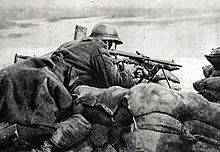Yser Front
The front was established following the Battle of the Yser in October 1914, when the Belgian army succeeded in stopping the German advance after months of retreat and remained largely static for the duration of the war.
[3] The Belgian government, under Charles de Broqueville, established itself in exile in Sainte-Adresse, a suburb of the nearby French city of Le Havre.
Albert was sceptical of the value of offensive warfare, advocated by the British and French, which he believed to be costly and unable to achieve decisive victory.
[1] Albert believed that a mediated peace was inevitable and that it served Belgium's national interest to continue to protect the territory it already held until the Germans could be forced to open negotiations.
[4] In 1914, the Christmas truce was observed in a number of parts of the line and a few Belgian and German troops met in no-man's land between the trenches.
[7] Its most celebrated work was the Open Letter to the Belgian King Albert I, drafted by Adiel Debeuckelaere, in 1917 which aired many of the movement's grievances.
Although the Frontbeweging was unsuccessful in the short term, it succeeded in creating a dedicated political party, the Frontpartij, in post-war Belgium after the German defeat delegitimized many other parts of the Flemish Movement implicated in collaboration with the occupation authorities.






